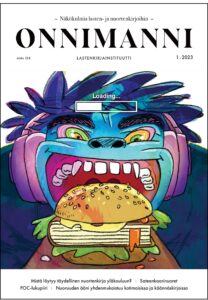
This year’s first issue of Onnimanni is dedicated to fiction for teens and young adults. During the past years, the number of Finnish original and translated titles issued for these age groups has dwindled. There is a need now for a broader range of books for readers with different interests and reading abilities.
In her article, Annu Viheriälehto summarizes her long-time career as a Finnish and literature lower secondary school teacher. She claims that there is a demand for more short books (less than 200 pages) on subjects of interest to young people. Fluent readers may also enjoy reading Easy to Read (EtR) books along ordinary teen books. Viheriälehto puts in a good word for boldly using verse novels, illustrated teen books and play texts in the classroom, since they can be read together out loud.
Librarian Sini Helminen’s article sums up roughly ten years of change within Finnish juvenile fiction. Anglo-American YA novels came to Finland in the early 2000s. Inspired by them, Finnish writers for teens gradually began to write similar books based on national myths and legends. The international influence is especially obvious in sci-fi and fantasy literature. YA books are challenging for librarians since it is not evident where they should be placed in order to best reach their readers. An adult interest in reading YA fiction has been booming in the United States, but there is no indication of a similar trend in Finland.
J.S. Meresmaa has interviewed four writers of juvenile fiction, who also find the various ways in which these books are categorized confusing. Today, Finnish teen books do not get the media-attention they deserve. Writing realistic fiction for this age group, authors do extensive background research among young people and employ young people as test-readers.
The Institute’s librarian Anna Tiitinen reads plenty of English-language American YA literature hot off the shelves. Today, Finnish bookshops front English-language YA books popular on social media. 70 % of all teen fiction translated into Finnish are of American origin. Still, Tiitinen would like more translations of good YA books on recent history or the future of mankind. The trigger warnings on YA books now commonly used in the United States, have quite recently begun to appear also in Finland.
Both Helminen and Tiitinen stress that teen fiction already give voice to a diverse range of young people. Pyry Aarnio’s pro gradu thesis studies transmasculinity and gender identity in the works of four Finnish writers of juvenile fiction. The novels studied depict youth and transgender as a transitional stage from one identity position to another. Using metaphoric figurative language, they reimagine a transsexuality previously associated with negative traits.
Aracelis Correa and Téri Zambrano founded the POC book club in Helsinki in 2020, because they wanted to read more works by POC authors. Since then, their venture has expanded and now offers a wide range of literature activities for schools. In her interview with Correa and Zambrano, Aino-Maria Kangas concludes that the book clubs offer POC youth peer support and provide other students with means to increase their understanding of diversity.
Translation Maria Lassén-Seger
